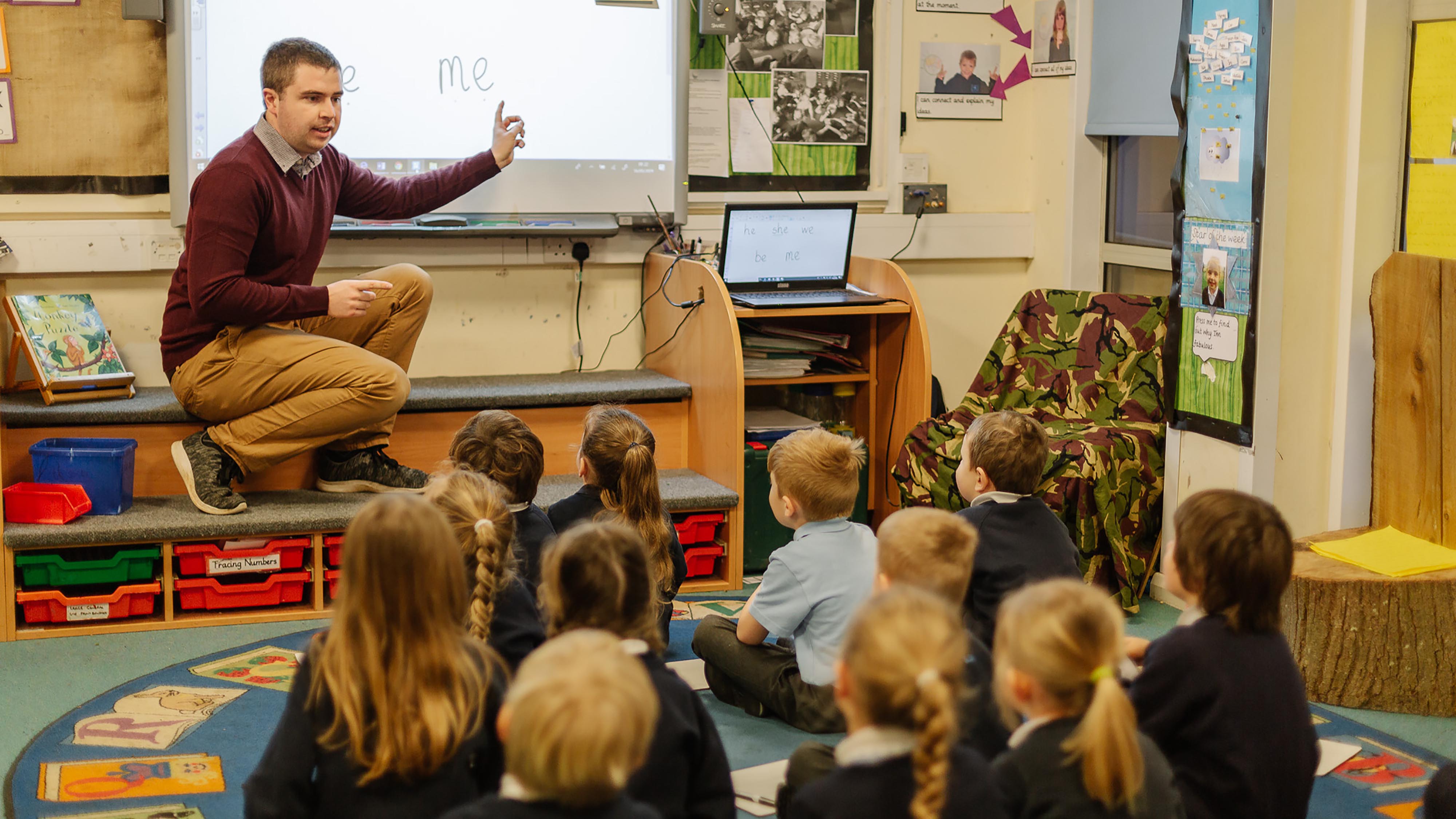How to get into primary teaching without a degree
If you don’t yet have a degree then there are various routes open to you to become a qualified primary teacher. The best one for you depends on your personal circumstances as well as how certain you are that you want to teach.
To teach in maintained schools in the UK you’ll need Qualified Teacher Status (QTS) and a degree at 2:2. Maintained schools are state schools overseen by the local authority, they are the majority of all schools.
There are lots of routes to earning a degree and QTS and we're about to explore them. But first, what even is QTS?

What is Qualified Teacher Status (QTS)?

Qualified Teacher Status (QTS) is a professional qualification for teachers. It is required to teach in state-run primary, secondary, and special schools. You need QTS if you want to qualify for the qualified teacher pay scale, which in turn enables you to join the Teachers’ Pension Scheme.
QTS is required for most teacher roles and leadership opportunities within UK schools. It is possible to teach in private schools, free schools and some academies without QTS, but not having it massively limits your career options.
There are a couple of pre-requisites to getting on to any undergraduate course that awards QTS. You must have level 4 or grade C or above in GCSE Maths and English, and GCSE Science for primary teaching.
Broadly speaking there are two routes to QTS:
1. An undergraduate teacher training degree that awards QTS
2. Any undergraduate degree followed by a one-year teacher training degree that awards QTS
To get on to a course with QTS you’ll also need school experience, which means you’ve spent time observing and helping with lessons in a school, and a Disclosure and Barring Service (DBS) check.
An undergraduate degree with QTS is the quickest way to qualify as a teacher. It takes three years of full-time study. But this route isn’t for everyone.
It may be that you can’t afford to be a full-time student for three years, or maybe you don’t meet the entry requirements. But fear not, there are plenty of other routes into primary teaching.
The other route is to choose an undergraduate course without QTS then do a one-year postgraduate teacher training course that awards QTS. That route usually equals four years of studying.
For completeness, we’ll add that Qualified Teacher Learning and Skills (QTLS) is available to teachers in the Further Education and Post-Compulsory Education sectors (i.e. teaching from age 14 up to adults). It is recognised as equivalent to QTS and there is no need to hold both awards.
Why choose an undergraduate teacher training degree with QTS?
QTS is awarded with some but not all Bachelor of Education (BEd), Bachelor of Arts (BA) or Bachelor of Science (BSc) courses. Always check with the provider as to whether or not QTS is included.
Degrees with QTS offer the fastest route to becoming a qualified teacher, typically taking three years.
Degrees with QTS combine study at university with placement blocks where you’ll develop practical skills. In university you’ll explore approaches to things like assessment, child development, classroom management, learning, marking, planning, subject knowledge, and teaching. It’s on placement that you get to put what you’ve learned into practice. You’ll need to spend at least 120 days in at least two schools to earn QTS.
School placements are typically longer on QTS than non-QTS courses and you’ll be required to teach and given full support to do so. You’ll gradually build your confidence and expertise in leading a class too, learning about things like special educational needs and disabilities, behaviour management, identifying pupil progress, planning, child development and learning through play. At the end of three years, you’ll be ready and qualified to teach in a primary school.
If you are very confident that you want to teach, then a course with QTS is perfect for you. You’ll develop deep knowledge of the skills and subject knowledge required to teach all the National Curriculum subjects and you’ll have the chance to specialise in the subjects that most interest you.
Molly King, a graduate of BEd Primary Education with QTS, explains how placement learning works:
“ BEd Primary Education includes one placement per year, allocated by the university to suit the needs of every individual. On placement you are expected to teach. The first-year placement is a block of four weeks, with follow-up blocks at the same school too. The second-year placement is a six week block and the third-year placement is a ten week block. It enabled me to understand exactly what is expected of me when I begin to teach.
" It's a quick and effective route into teacher training. You’ll develop into a fantastic and confident teacher by the end of your third year, obtaining vital knowledge through taught sessions and practice. However, the workload is higher than that on the BA Primary Education, which is the closest non-QTS course here at Marjon. ”
Why choose an undergraduate degree without QTS?
The great thing is that there are loads of non QTS courses to choose from. You start with a three-year undergraduate degree and follow it with a one-year qualification to earn QTS such as Postgraduate Certificate in Education (PGCE) or School Direct.
Studying for an undergraduate degree doesn’t have to mean spending three years full-time at university. Some degrees are designed so that you can study while you work.
Chris Simpson, a Senior Lecturer in Education at Plymouth Marjon University, explains how this works: “Some degrees are designed for people who are working. It enables you to remain in your work with children. You’ll learn to connect the theoretical concepts that are taught in university, and the reading you do, to your day-to-day work. For people with teaching assistant experience it can be like lighting the blue touch paper because they already know a lot of this stuff, but they don't know they know it, and they don't know why it works, and they don't yet know what language to use to explain what's happening. It’s exciting and it opens doors in their careers.
“You earn while you learn. For example on the FdA Learning and Teaching you attend university for 20 days per year and must work alongside this in a relevant role in education, whether paid or voluntary, for a minimum of 10 hours per week. After two years you can graduate with a foundation degree and then top it up to an honours degree by joining the third year of an education degree”.
It’s worth noting that while you can do any undergraduate course, doing an education course makes you a strong candidate when you come to apply for PGCE Primary or School Direct.
For a full-time university experience BA (Hons) Primary Education is a great option, but when it comes to non-QTS courses there are many options. You can pick any branch of education that excites you and develop the specialist knowledge and skills that can help in in teaching or other careers. For example, if you are drawn to working with very young children check out BA Early Childhood Studies, if you’re never happier than when out in the great outdoors then try BA (Hons) Outdoor Adventure Education, if you’re drawn to empowering disabled children see BA (Hons) Special Educational Needs and Disability Studies, or if sport is totally your thing try BA (Hons) Physical Education or BA Sports Coaching and Physical Education.
Miles Smith, course leader of BA (Hons) Primary Education, explains more: “My students come from all walks of life. Some don’t have the standard entry requirements for teaching but have taught in some way. They tend to come with convincing personal statements, real-world school experience, and recommendations from Headteachers. By the end of the BA, they have the extra knowledge they need to get taken on as a trainee teacher and go on to become great teachers. Other students want to keep their options open. They are interested in child development and education as well as teaching and BA Primary Education is broad enough to cover all those things.”
After a non-QTS course you'll need a minimum of a 2:2 for your undergraduate degree to get on to a postgraduate teacher training course. You don’t have to study at the same university for your undergraduate and postgraduate courses, though you might choose to.
BA Primary Education graduate Shannon Angwin tells us about her experience:
“ I’ve learned a lot of theories and ideas. I feel the course helped me to understand the type of teacher I aim to be, highlighted education theorists and enabled me to gain confidence in the classroom.
" After presenting a couple of times in lecturers lectures, I began to feel comfortable with standing up in front of others and presenting my ideas, a skill that I will continue to take forward into my School Direct. You are allocated a personal tutor to help you with any needs throughout the course and she was always there whenever she was needed. I feel confident going forward. ”
Which is the best route into teaching for me?
To recap, you need Qualified Teacher Status (QTS) to become a fully qualified teacher and we’ve looked at the main differences between undergraduate education courses with and without QTS. So now for the million-dollar question: Which route into teaching is right for you? Let's look at some things to consider...
How much time have you got to study?
QTS courses are typically full-time. You can study for some non-QTS courses full-time or part-time which may offer more flexibility around family or work commitments. If you take a non-QTS undergraduate degree, you’ll need to follow it with a postgraduate teacher training course to earn your QTS. This bit will be a full-time course and most trainees say it’s challenging but very rewarding.
On a related note, undergraduate courses with QTS courses tend to have more hours of lecturers, practicals and independent study. Non-QTS courses can be a better fit if you have other time commitments.
How are you going to fund your studies?
Some non-QTS education courses are flexible enough for you to keep working in education if you already have a job.
You will find that different courses charge different course fees so cost out your various routes to QTS as this could save you thousands. Check the provider websites for full details. You are also eligible to apply for Student Finance to cover your tuition fees and living costs when you take any undergraduate degree, and again if you go on to PGCE and School Direct courses.
Rarely are government bursaries available for primary trainees, but there are more options for secondary trainees. Bursaries change every year depending on the skills most needed at the time.
How certain are you that you want to teach?
On degrees with QTS you’ll always be required to teach on placements, whereas with non-QTS teaching on placements isn’t essential. You can opt whether to teach or not.
Also, non-QTS courses keep your options open, they are great not just for progressing to teacher training but also to other careers in education, or to Master’s and then PhD level study.
Having no degree today doesn’t stop you becoming a teacher in the future. Loads of great teachers come to it that bit later in life, as a career change or after a career break. That extra bit of life experience can really add to what you are able to do in the classroom.


